企业偿债能力分析外文文献[精品文档]
- 格式:doc
- 大小:52.00 KB
- 文档页数:7
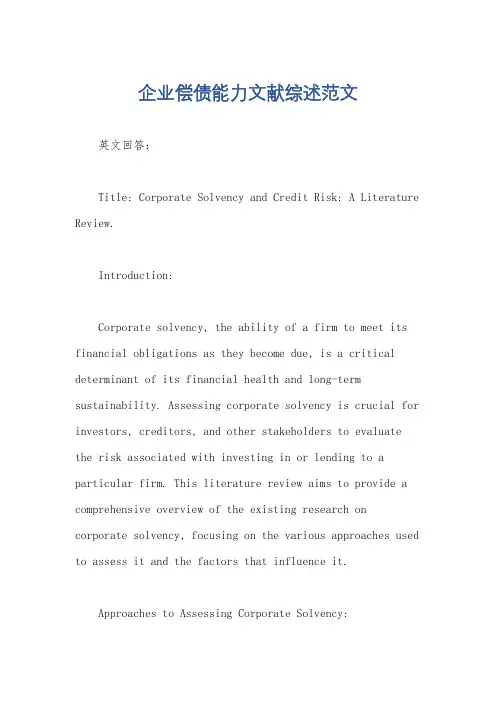
企业偿债能力文献综述范文英文回答:Title: Corporate Solvency and Credit Risk: A Literature Review.Introduction:Corporate solvency, the ability of a firm to meet its financial obligations as they become due, is a critical determinant of its financial health and long-term sustainability. Assessing corporate solvency is crucial for investors, creditors, and other stakeholders to evaluate the risk associated with investing in or lending to a particular firm. This literature review aims to provide a comprehensive overview of the existing research on corporate solvency, focusing on the various approaches used to assess it and the factors that influence it.Approaches to Assessing Corporate Solvency:Researchers have developed numerous approaches to assess corporate solvency, each with its strengths and weaknesses. Some of the most widely used methods include:Financial Ratios: Financial ratios, such as the debt-to-equity ratio and the current ratio, provide insightsinto a firm's financial structure, liquidity, and profitability. A high debt-to-equity ratio, for example, may indicate a higher risk of insolvency.Credit Scoring Models: Credit scoring models, such as the Altman Z-Score and the Moody's KMV EDF Score, use statistical techniques to assign a score to a firm based on various financial and non-financial factors. A higher score generally indicates a lower risk of default.Cash Flow Analysis: Cash flow analysis examines the flow of cash into and out of a firm, providing insightsinto its ability to generate cash from operations and meet its obligations. A negative cash flow from operations can raise concerns about solvency.Going-Concern Assessment: Going-concern assessments consider a firm's future prospects and ability to continue operating as a going concern. Factors such as industry trends, competitive pressures, and management effectiveness are evaluated to assess the likelihood of a firm's survival.Factors Influencing Corporate Solvency:The solvency of a firm is influenced by a wide range of factors, both internal and external. Internal factors include:Management Quality: Effective management, with astrong understanding of financial risk and a commitment to sound financial practices, can enhance corporate solvency.Capital Structure: The composition of a firm's debtand equity financing can impact its solvency. A higher proportion of debt financing increases the risk of insolvency.Business Model: The underlying business model,including industry dynamics, competitive pressures, and operating margins, can affect a firm's ability to generate cash and meet its obligations.External factors influencing corporate solvency include:Economic Environment: Economic downturns, recessions, and market volatility can adversely impact a firm's sales, profits, and cash flow, increasing the risk of insolvency.Regulatory Changes: Changes in regulatory policies, such as increased capital requirements or accounting standards, can impose additional financial burdens on firms and affect their solvency.Competitive Landscape: Intense competition, market share erosion, and technological disruptions can reduce a firm's profitability and weaken its financial position.Implications for Investors and Creditors:Understanding corporate solvency is essential for investors and creditors to make informed decisions.Investors need to assess the risk of insolvency associated with potential investments, while creditors need to assess the creditworthiness of firms to mitigate the risk of default. The findings of this literature review provide insights into the approaches used to assess corporate solvency and the factors that influence it, enabling investors and creditors to make more informed judgments about the financial risks involved.Conclusion:Corporate solvency is a complex and multifacetedconcept that should be evaluated using a comprehensive approach that considers both financial and non-financial factors. By employing appropriate assessment techniques and understanding the factors that influence corporate solvency, investors and creditors can better assess the risk associated with investing in or lending to particular firms, enabling them to make more informed financial decisions.中文回答:企业偿债能力文献综述。
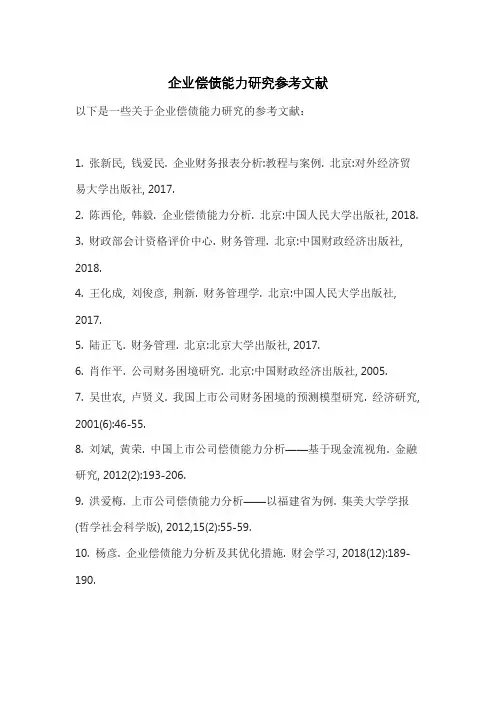
企业偿债能力研究参考文献
以下是一些关于企业偿债能力研究的参考文献:
1. 张新民, 钱爱民. 企业财务报表分析:教程与案例. 北京:对外经济贸易大学出版社, 2017.
2. 陈西伦, 韩毅. 企业偿债能力分析. 北京:中国人民大学出版社, 2018.
3. 财政部会计资格评价中心. 财务管理. 北京:中国财政经济出版社, 2018.
4. 王化成, 刘俊彦, 荆新. 财务管理学. 北京:中国人民大学出版社, 2017.
5. 陆正飞. 财务管理. 北京:北京大学出版社, 2017.
6. 肖作平. 公司财务困境研究. 北京:中国财政经济出版社, 2005.
7. 吴世农, 卢贤义. 我国上市公司财务困境的预测模型研究. 经济研究, 2001(6):46-55.
8. 刘斌, 黄荣. 中国上市公司偿债能力分析——基于现金流视角. 金融研究, 2012(2):193-206.
9. 洪爱梅. 上市公司偿债能力分析——以福建省为例. 集美大学学报(哲学社会科学版), 2012,15(2):55-59.
10. 杨彦. 企业偿债能力分析及其优化措施. 财会学习, 2018(12):189-190.。

文献信息文献标题:Firm’s Size and Solvency Performance: Evidence from the Malaysian Public Listed Firms(公司规模和偿债能力:来自马来西亚上市公司的证据)文献作者:AK Ramin等文献出处:《Journal of Engineering and Applied Sciences》,2017, 12(5): 1240-1244字数统计:英文3045单词,15732字符;中文4929汉字外文文献Firm’s Size and Solvency Performance: Evidence from theMalaysian Public Listed FirmsAbstract Firm solvency is one of the important indicators in measuring firm’s performance. Firm ability to grow and sustaining their business in the highly competitive business environment depends significantly on its cash flow management capacity that subsequently results to a business stay solvent at every phase of business life cycle. Early detection of financial distress is important for every firm of various sizes. Previous findings on firm’s size and solvency performance varies which tendency on agreeing to the assumption that larger firms have the advantages to avoid insolvency as compare to smaller firms. However, previous studies have also revealed that larger firms such as public listed company were not escape from facing financial distress which eventually lead to insolvency. Therefore, the study was aimed to mdentify the influence of firm’s size and solvency performance of public listed firms in Malaysia. A total of 149 firms were used to measure their financial data performance for a period between 2011 and 2014. Firm total assets and paid capital were used as a proxy to firm size. The current ratio and debt ratio were used as a proxy to measure the solvency performance. The study found that firm size measuredby total assets has moderately influence the solvency performance of firms indicated by the debt ratio and current ratio. However the firm size measured by paid-up capital has lesser influence on solvency performance measured by debt ratio and no influence on current ratio.Kev words: Current ratio, debt ratio, firm size. Insolvency, liquidity, SolvencyINTRODUCTIONIn any situation, firms should be able to meet short and long term obligation to achieve operational sustainability. In this situation, firms with operational sustainability were regarded as in the position of solvency. Insolvency occurs when a firm’s total liabilities exceeded a fair valuation of its total assets. Previous study by Brigham and Houston (2012) described technical insolvency as the position whereby firms were unable to meet their current obligations as they fall due (that is the firm’s current assets are lower than its current liabilities) despite having higher total assets than the total liabilities. Early detection of financial distress is important in avoiding insolvency. Public listed firms were relatively capable in managing liquidity to ensure that they remain in solvency position sustainably. Previous findings on the relation ship between firm’s size and solvency performance shows mixed result which tendency on agreeing to the assumption that large firms have the advantages over small firm to remain solvent. However, prior studies have also revealed that larger firms such as public listed companies were not immune from having financial distress which eventually leads to insolvency. Firm ability in servicing and repaying debts was the main indicator of the solvency position measurement of any firms (Zhang and Zhang, 2010). Earlier empirical studies by Coleman (2002), Obert and Olawale (2010) that focus on larger firm in various developed countries suggest that large firms showed that size have significant impact on the ability in serving debts lead to greater chances in sustaining their solvency position. This finding consistent with a study by Sahudin et al. (2011 ) in which larger firms allows a greater level of debt management towards their ability to sustain the solvency position. Despite many findings revealed that larger firms have an advantages over the smaller firms in managing their liquidity,there were cases particularly in which Practice Note (PN 17) was served to considerably large firms listed in Bursa Malaysia as a result of liquidity issues. PN 17 is the control procedure specifically for public listed companies which are facing financial distress and to be delisted from the stock exchange. There were 21 firms subjected to PN 17 as at first half of 2015 bringing the total listing of financial distress firms to 2.32% of the total listed firms on the stock exchange. Shareholders and investors continue to demand for healthy firms to ensure their investments. Solvency and liquidity of firms would remains significant elements for managers to manage for sustainability of the firms. It is pertinent for managers to understand about business failures, its causes and its possible remedies (Sulub, 2014). Therefore, the study was aimed to mdentify the influence of firm’s size on solvency performance of public listed firms on the Bursa Malaysia (BM).LITERIATURE REVIEWPast researchLun and Quaddus (2011 ) in their study among Hong Kong electronic industry propagated that firm size does influence the performance of business. In other findings suggested that smaller firms were more likely to issue equity while larger firms are more likely to issue debt rather than equity which influence the liquidity. Past study done by Cassar and Holmes (2003) and Esperanca et al. (2003) found a positive relationship between firm size and long-term debt but a negative relationship with short-term debt which eventually influence the liquidity. Other study suggested that firm size and capital structure strategy may influence firm’s solvency performances. Other finding by Beck et al. (2008) indicated that firms size influence the firm’s performance which includes the solvency and liquidity operation. Findings from Rajeev indicated that small firms were much faced higher risks of liquidity as compared to those larger firms. Therefore, these two findings show a risk versus return trade-off that exists at the firm performance level in relation to firm’s size. Justification of this findings propagated that larger firms have the advantages to access for better resources and skill competencies to better manage the firm. Otherproponent to this hypothesis added that economies of scale only can only be found at larger firms (Nguyen and Reznek, 1991). Despite many findings propagated that larger firms have better performance in term of solvency, there were findings which argued that smaller firms may also performance better in term of efficiency, growth and liquidity. Recent finding by Vithessonthi and Tongurai (2015), firm size does not influence the firm performances during the 2000-2009 Thailand financial crisis.Other finding by Campos and Sanchis (2015) firm’s size among agricultural industry in Spam does not influence the performance of liquidity and solvency of the industry. In general, performance of firms such as the productivity, firm size to be found in mix ed contribution towards firm’s productivity which could influence the financial health of the operation (Pompe and Bilderbeek, 2005). Earlier finding by Michaelas et al. (1999) also supported that a debt ratio and firm’s size could correlate depending on the other factors within the firms.Other findings by Bourlakis et al. (2014) suggest different small firm performed better in case of agriculture industry in Greek. Small firms preferred to opt for short-term finance as compared to larger firms and better performed as opposed to larger firms. It may caused small firms highly sensitive to short term economic environment as oppose to larger firms. It is concluded that the relationship between firm’s size and firms performance findings varies as many other fac tors may influence the both variables. It is therefore, continuous study on this issues remain relevant as economic factors continue to influence firms operation.Firm sizeFirm size has been widely used as a control variable in empirical research specifically to corporate finance. Firm size matter for many reasons, it is said that larger firms are better in managing their cash flow, therefore difficult to fail and liquidate (Shumway, 2001 ). Size can also be the proxy for the volatility of firm’s assets. Additionally, measurement of firm size varies according to the research perspective. Rajeev suggested that firm size is defined according to the value of a firm’s assets. In addition, Sahudin et al. (2011 ) propagated that the size of firm is defines as the logarithm of total assets of the firms used in business; Firm s= log e,Total asset. Previous scholar such as Kato and Honho and Sun preferred to use total assets value to represent firm’s size to measure liquidity and predictor for bankruptcy. While some researchers used asset value as the proxy to firm’s size, others have suggested alternative measurement such as paid up capital as a proxy for firm’s size. According to Allen paid-up capital for a firms company is the number of shares outstanding multiplies the face value of the shares. Kidanu defined paid-up capital as the amount of capital which is contributed/paid by owner(s) during the establishment of a firm adopting measurement of firm’s size using paid-up capital is a more stable measure of firm size (Ponnu and Okoth, 2009). Other researcher suggested that total assets as a proxy for firm size indicated the influence of firm’s size and solvency performance (Vithessonthi and Tongurai, 2015). In view of the widely adopted by other researcher, this stud y employed this variable as the proxy for firm’s size.SolvencyThe importance of knowing solvency through the optimal debt ratio could help policymakers and financial managers to formulate an appropriate financing policy that could prevent companies from going into financially distressed situation due to excessive level of debt (Ahmad and Abdullah, 2011). Previous researches works widely suggested that ‘Debt Ratio’ (DR) and ‘Debt to Equity Ratio’ (DER) be used as a proxy to solvency (Khidmat and Rehman, 2014). DR was widely used as its reflecting the company’ liability situation and has the best protection degree for borrower’s benefit and it is the basic ratio in translatmg financing structure as well as easy to define and calculate (Li and Jian, 2008). Other proponent on the use of DR was finding by Ahmad and Abdullah (2011) in which DR was consistent with trade-off theory which hypothesize that high debt ratio will lead to financial distress and thus deteriorate the firm value. Other measurement on solvency was based on performance of Current Ratio (CR). The CR measure a firm’s ability to pay current obligations on business such as operating and financial expenses is current ratio. Current ratio consists of cash and near-cash assets (together called “current” assets) of a business on one side and immediate payment obligations (current liabilities) on the other side. Using the CR to measure solvency enable firms to monitor paymentobligations include dues to suppliers, operating and financial expenses that must be paid shortly and maturing installments under long-term debt (Saleem and Rehman, 2011; Altman, 1968). It is therefore, CR and DR were adopted in this study as a proxy for solvency performance.MATERIALS AND METHODSThis study employs quantitative methodology involving collection of secondary audited financial data from 149 firms for a period between 2011 and 2014 representing a sample size of 16% from a total of 934 firms listed on Bursa Malaysia. Quantitative method based on secondary data was employed as simple random sampling technique was employed to select a sample representing type of sector and firm size. Table 1 shows industrial product accounts the largest number of the samples which were 47 firms (31 .5%) and followed by trade and service sector of 35 firms (23.5%). There were 25 firms or 16.8% representing consumer sector. Property sector accounts for 12.1 % or 18 sample firms. The remaining samples came from construction, plantation and technology and hotel industry. Detail breakdown of samples firms is depicted in Table 1 (Dhawan, 2001).Table I : Samples firms by sectorsSector Frequency PercentageIndustrial product 47 31.5Trade and service 35 23.5Consumer 25 16.8Property 18 12.1Construction 9 6.0Plantation 7 4.7Technology 5 3.4Finance 3 2.0Total 149 100.0Data observations covers annual reports from 149 firms for 4 years period were analysis using excel prior to further analysis using SPSS. Firm size was measure by total assets of the firms and paid up capital. Total assets were derived as:Fixed assets + Current assets (1) Debt ratios were calculated as:Total debt/total asset (2)Current ratios were calculated as:Total current assets/Total current liabilities (3)RESULTS AND DISCUSSIONDescriptive analysis on debt ratios and current ratio resulted in their respective mean scores of each firm’s size category as depicted in Table 2 mean score for DR varies according to firm’s size in which small f irms scored mean of 0. 259, medium size; 0.378 and larger firm scored mean of 0. 452. For the CR, small firm scored mean of 6.605, medium firm; 2.534 and larger firm scored 2.562. Correlation test on the relationship between firm size (total assets) and DR yielded p<0. 005 and r-value of 0.313 indicated that there was a moderate positive correlation between two variables as depicted in Table 3. Firm size (total assets) value correlate with the performance firm’s debt ratio indicating that as the asset value increase it will also resulted to moderate and significant increase in the firm’s DR.Table 2: Mean score of DR and CR for various firm’s sizeFrim size (total assets) Mean Debt Ratio (DR) Mean Current Ratio (CR) Small frim (TA<RM 100mil) 0.259 6.605 Medium frim (RM 100mil<TA<RM 499 mil) 0.378 2.534Large frim (TA>RM 499 mil) 0.452 2.562 Table 3: Correlation between total assets and debt ratio from year 2011 -2014 spearman's rho DR TADRCorrelation coefficient 1.000 0.313**Sig. (2-tailed)- 0.000N 149 149TACorrelation coefficient0.313** 1.000Sig. (2-tailed)0.000 -N 149 149* *Correlation is significant at the 0.01 level (2-tailed)Further, test on the correlation between firm sizes (total assets) on CR yielded r-value of 0.194 and p-value of 0.018, p<0. 005 indicated that was a weak and significant positive correlation between the two variables as highlighted in Table 4.Table 4: Correlation between total assets and current ratio from years 2011-2014spearman's rho CR TACRCorrelation coefficient 1.000 0.194*Sig. (2-tailed)- 0.018N 149 149TACorrelation coefficient0.194* 1.000Sig. (2-tailed)0.018 -N 149 149* *Correlation is significant at the 0. 05 level (2-tailed)A test was also conducted on the relationship between firm size measures by paid-up capital against the DR. The finding indicated that there was a weak and significant positive correlationbetween paid-up capital and debt ratio, r = 0.299, p<0. 005 (Table 5 and 6).Table 5: Correlation between paid-up capital and debt ratio from years 2011-2014 spearman's rho DR Paid-up capitalDRCorrelation coefficient 1.000 0.299**Sig. (2-tailed)- 0.000N 149 149Paid-up capitalCorrelation coefficient0.299** 1.000Sig. (2-tailed)0.000 -N 149 149Table 6: Correlation between paid-up capital and current ratio from years 2011-2014 spearman's rho CR Paid-up capitalCRCorrelation coefficient 1.000 0.214**Sig. (2-tailed)- 0.009N 149 149Paid-up capitalCorrelation coefficient0.214** 1.000Sig. (2-tailed)0.009 -N 149 149The final test on the relationship between paid-up capital and current ratio yielded r = 0. 214, p<0. 009. The result indicated that there was a weak and significant positive correlation between the two variables. All in all, the correlation analysis indicates that there exist significant positive correlation between measure of firm sizeand solvency performance. Nevertheless, it is important to note the correlations are rather weak. With highest linear correlation at 0.313 it does suggest that firm size has quite minimum impact on firm’s solvency performance. The findings also support prior studies that the relationship between firm size and solvency performance is mixed.CONCLUSIONSummary of the findings can be concluded that firm’s size measured by total assets does influence the firm’s solvency performance for both measurement of debt ratio and current ratio. The ability to optimize higher assets value may help firm improve their liquidity. This findings was consistence with previous studies by Michaelas et al. (1999), Hall et al. (2000) and Sogorb-Mira (2005) in which a positive relationship between firm size (assets) and leverage and solvency measured in the ratio of total debt (long-term debt).As for the relationship between paid-up capital and solvency performance, the debt ratio found to be influence by the paid-up capital while current ratio showed no relationship with the size of paid-up capital. It was nature of paid-up capital which used as initial resources to start the business operation. Over the time paid up capital relatively experience fewer changes despite the need for additional resources. Firms are preferred to sources external funding as compare to equity financing. However, the use of debt can also increase the financial risk of a firm and lead to the insolvency. According to Coleman and Cohn (2002) and Coleman (2002), debt is one of the variables that can cause insolvency for most of firms. Failure rates in the range of 50-75% were commonly cited for smaller firms, making it difficult for smaller firms to raise external capital from either debt or equity providers. The weak of financial structure as reflected by the gearing (debt-equity ratio) has been found to be the key source of insolvency. Many firms were unable to keep up this high debt ratio and, later become insolvent. A high debt ratio in itself, does not make a firm insolvent as long as the firm is earning enough to cover interest and principal payments when it they come due. However, the more leveraged a firm is the more vulnerable it is tobankruptcy. Therefore, the flow of earnings and the ability of the firm to make interest and principal payments will determine whether the firm will actually become insolvent or otherwise (Kim and Lee, 2002). The prediction and prevention of financial distress is one of the major factors that should be analyzed in advance as an early warning signal and to avoid bankruptcy. In addition to the awareness that can make a company successful, it is also useful for managers to have an understanding of business failures and bankruptcy, its causes and its possible remedies. In conclusion, firm size does matter, although the impact is quite small in term of their influence towards solvency performance. However, equally important is the ability of the managers to leverage available resources within the firms to strive for healthy financial position and remain solvent all the time.中文译文公司规模和偿债能力:来自马来西亚上市公司的证据摘要企业偿债能力是衡量企业绩效的重要指标之一。
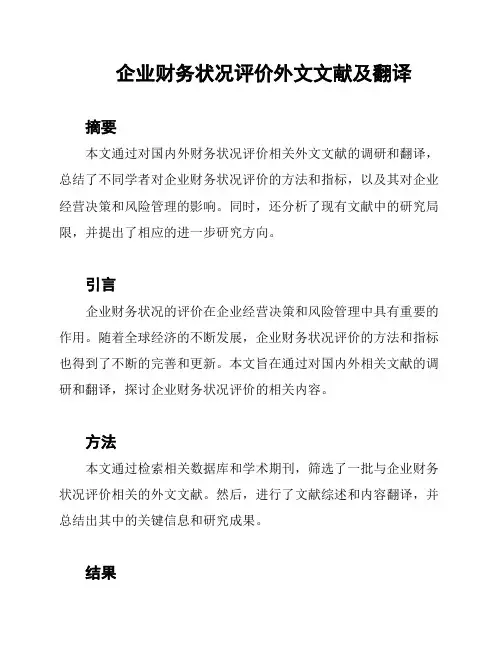
企业财务状况评价外文文献及翻译摘要本文通过对国内外财务状况评价相关外文文献的调研和翻译,总结了不同学者对企业财务状况评价的方法和指标,以及其对企业经营决策和风险管理的影响。
同时,还分析了现有文献中的研究局限,并提出了相应的进一步研究方向。
引言企业财务状况的评价在企业经营决策和风险管理中具有重要的作用。
随着全球经济的不断发展,企业财务状况评价的方法和指标也得到了不断的完善和更新。
本文旨在通过对国内外相关文献的调研和翻译,探讨企业财务状况评价的相关内容。
方法本文通过检索相关数据库和学术期刊,筛选了一批与企业财务状况评价相关的外文文献。
然后,进行了文献综述和内容翻译,并总结出其中的关键信息和研究成果。
结果1. 企业财务状况评价方法根据文献翻译和分析,目前学者们在企业财务状况评价方面主要采用以下方法:- 财务比率分析:通过对企业财务报表的比率分析,评估企业的偿债能力、盈利能力、运营效率等方面的状况。
- 资产负债表分析:通过对企业资产负债表的分析,揭示企业的资产结构、债务水平和净资产价值等方面的情况。
- 现金流量分析:通过对企业现金流量表的分析,探讨企业的现金流入流出情况以及可持续性问题。
- 经验判断和专家评估:通过对企业经营情况的判断和专家的评估,综合考虑多个因素对企业财务状况的影响。
2. 企业财务状况评价指标研究发现,在企业财务状况评价中,常用的指标包括:- 流动比率:反映企业短期偿债能力的指标。
- 速动比率:更加严格地评估企业短期偿债能力的指标。
- 盈利能力指标:如净利润率、毛利率等,用于评估企业的盈利水平。
- 储蓄比率:评估企业的盈利再投资能力的指标。
- 负债比率:反映企业债务水平和承担风险的指标。
3. 对企业经营决策和风险管理的影响学者们的研究表明,企业财务状况评价对企业经营决策和风险管理有重要影响。
合理评估企业财务状况可以帮助企业制定更加科学的经营决策,提高企业效益和竞争力。
同时,对企业财务状况的评价还可以帮助企业及时发现和应对潜在的经营风险,降低经营风险带来的不确定性。
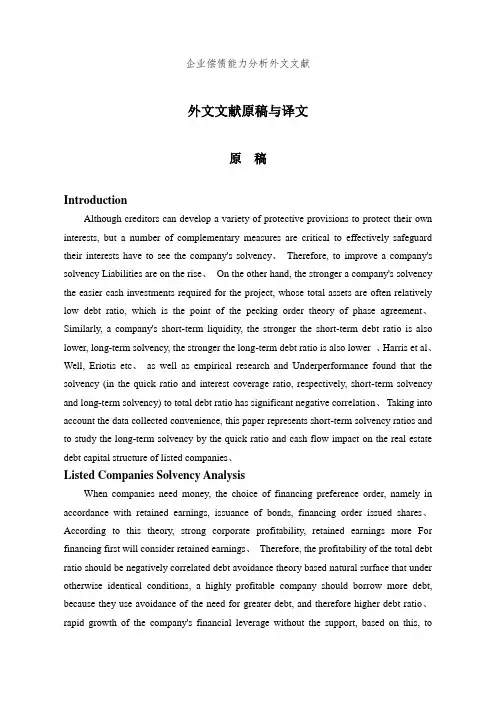
外文文献原稿与译文原稿IntroductionAlthough creditors can develop a variety of protective provisions to protect their own interests, but a number of complementary measures are critical to effectively safeguard their interests have to see the company's solvency、Therefore, to improve a company's solvency Liabilities are on the rise、On the other hand, the stronger a company's solvency the easier cash investments required for the project, whose total assets are often relatively low debt ratio, which is the point of the pecking order theory of phase agreement、Similarly, a company's short-term liquidity, the stronger the short-term debt ratio is also lower, long-term solvency, the stronger the long-term debt ratio is also lower 、Harris et al、Well, Eriotis etc、as well as empirical research and Underperformance found that the solvency (in the quick ratio and interest coverage ratio, respectively, short-term solvency and long-term solvency) to total debt ratio has significant negative correlation、Taking into account the data collected convenience, this paper represents short-term solvency ratios and to study the long-term solvency by the quick ratio and cash flow impact on the real estate debt capital structure of listed companies、Listed Companies Solvency AnalysisWhen companies need money, the choice of financing preference order, namely in accordance with retained earnings, issuance of bonds, financing order issued shares、According to this theory, strong corporate profitability, retained earnings more For financing first will consider retained earnings、Therefore, the profitability of the total debt ratio should be negatively correlated debt avoidance theory based natural surface that under otherwise identical conditions, a highly profitable company should borrow more debt, because they use avoidance of the need for greater debt, and therefore higher debt ratio、rapid growth of the company's financial leverage without the support, based on this, toselect 378 samples from the 500 largest US companies, the researchers found that regardless of whether there is an optimal capital structure, the company's liabilities are directly correlated with growth、Growth is the fundamental guarantee company solvency, so whether short-term loans or long-term loans and creditors, as the company's growth as a positive signal, so the listed companies in recent years of growth, the higher its rate and short-term assets The higher rate of long-term assets and liabilities, total assets and liabilities naturally higher, but the impact on growth of real estate companies listed on a smaller debt ratio (coefficient is small)、The risk of firm size and capital structure affect the growth has a similar conclusion, it appears that creditors, especially banks that the company scale is a measure of credit risk is an important consideration index, the greater the company size, the more stable cash flow, bankruptcy it is smaller, the creditors are more willing to throw an olive branch large-scale enterprises、The actual controller of the listed companies category to total debt ratio of the impact factor of a 0、040017, indicating that non-state-controlled listed company's total assets and liabilities higher than the state-owned holding companies、The reason for this phenomenon may be non-state-controlled listed companies pay more attention to control benefits, do not want to dilute their control over equity financing, and therefore more inclined to debt financing, which may also explain the non-state-controlled listed companies better use of financial leverage enterprises bigger and stronger impulses、In addition, the actual control of listed companies category short-term impact on asset-liability ratio is a 2、3 times its impact on long-term debt ratio, which shows the non-state-controlled listed companies prefer to take advantage of short-term debt to expand its operations、Current research on factors affecting capital structure point of view there are many factors in various industries concerned is not the same, according to industry characteristics and particularity, we mainly focus on the following aspects to analyze the factors industry capital structure、The article explained variable - capital structure for the asset-liability ratio, generally refers to the total debt ratio, but for more in-depth study of capital structure of listed companies, the paper from the total debt ratio, short-term assets and liabilities and long-term debt ratio of three angles of Capital structure explanatory、At present, domestic and foreign scholars analyzed factors on capital structure mostly used multiple linear regression, as usual statistical regression function in the form of their choice is often subjective factors, but ordinary regression methods to make function with average resistance, most such functions excellent and objectivity are often difficult to reflect、base stochastic frontier model (Stochastic Frontier) in data envelopment analysis (DEA) method, estimate the effective production frontier using mathematical programming method, namely the experience of frontier production function, overcome DEA method assumes that there is no random error term, the better to reflect the objectivity and optimality ¨J function, currently in the field of economic management, sociology and medicine, began to get more and more applications、Therefore, in this paper, stochastic frontier model data on the capital structure factors listed real estate companies conducted a comprehensive analysis, in order to provide a better scientific basis for the study of the optimal capital structure of real estate enterprises、Listed company's solvency and overall asset-liability ratio was significantly negatively correlated with short-term liquidity has a decisive influence on the short-term asset-liability ratio、Similarly, long-term solvency also has a decisive influence on long-term assets and liabilities、Industry higher total debt ratio particularly high proportion of short-term debt is one of the main business risks, thus increasing solvency of listed companies, especially short-term liquidity (that is, to obtain a stable short-term cash flow)、reduce its asset liability ratio and effective risk management choice ROA of listed companies is much greater influence than ROE of asset-liability ratio, and affect the relationship is inconsistent, ROE is higher, the higher the total debt ratio, while the ROA high, the lower the rate of the total assets and liabilities, and short-term liabilities ROA more obvious, this difference is mainly due to the special structure of listed companies due to the nature of the capital, and therefore need to improve the capital structure of listed companies, namely to reduce the total assets and liabilities rate debt structure and the need to reduce the proportion of short-term debt in particular, in order to enhance the company's profitability ROA、growth and company size has a significant positive impact on the capital structure, which is mainly due to the growth of the company's solvency is fundamental, The size of the company is the main indicator to measure the bankruptcy creditor risk、Therefore, listed companies shouldbe radically to grow through continuous growth and development of enterprises, so that the total debt ratio has a high margin of safety, through growth to continue to resolve the financial risk than non-state-owned holding companies controlling more use of financial leverage motivation and apparently relied on short-term liabilities, which may lead to more serious financial risk especially short-term business risks, so that the non-state-owned holding listed companies should establish more strict risk prevention system、译文介绍虽然债权人可以通过制定各种保护性条款来保障自己的利益,但都就是一些辅助性的措施,能够有效保障她们利益的关键还得瞧公司的偿债能力。
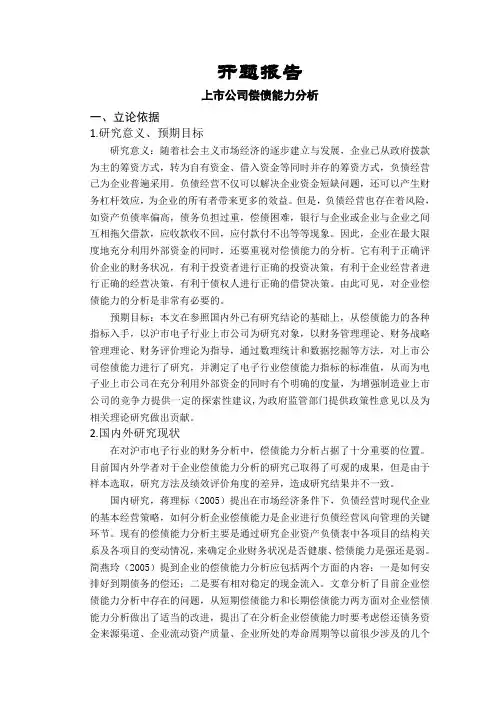
开题报告上市公司偿债能力分析一、立论依据1.研究意义、预期目标研究意义:随着社会主义市场经济的逐步建立与发展,企业已从政府拨款为主的筹资方式,转为自有资金、借入资金等同时并存的筹资方式,负债经营已为企业普遍采用。
负债经营不仅可以解决企业资金短缺问题,还可以产生财务杠杆效应,为企业的所有者带来更多的效益。
但是,负债经营也存在着风险,如资产负债率偏高,债务负担过重,偿债困难,银行与企业或企业与企业之间互相拖欠借款,应收款收不回,应付款付不出等等现象。
因此,企业在最大限度地充分利用外部资金的同时,还要重视对偿债能力的分析。
它有利于正确评价企业的财务状况,有利于投资者进行正确的投资决策,有利于企业经营者进行正确的经营决策,有利于债权人进行正确的借贷决策。
由此可见,对企业偿债能力的分析是非常有必要的。
预期目标:本文在参照国内外已有研究结论的基础上,从偿债能力的各种指标入手,以沪市电子行业上市公司为研究对象,以财务管理理论、财务战略管理理论、财务评价理论为指导,通过数理统计和数据挖掘等方法,对上市公司偿债能力进行了研究,并测定了电子行业偿债能力指标的标准值,从而为电子业上市公司在充分利用外部资金的同时有个明确的度量,为增强制造业上市公司的竞争力提供一定的探索性建议,为政府监管部门提供政策性意见以及为相关理论研究做出贡献。
2.国内外研究现状在对沪市电子行业的财务分析中,偿债能力分析占据了十分重要的位置。
目前国内外学者对于企业偿债能力分析的研究已取得了可观的成果,但是由于样本选取,研究方法及绩效评价角度的差异,造成研究结果并不一致。
国内研究,蒋理标(2005)提出在市场经济条件下,负债经营时现代企业的基本经营策略,如何分析企业偿债能力是企业进行负债经营风向管理的关键环节。
现有的偿债能力分析主要是通过研究企业资产负债表中各项目的结构关系及各项目的变动情况,来确定企业财务状况是否健康、偿债能力是强还是弱。
简燕玲(2005)提到企业的偿债能力分析应包括两个方面的内容:一是如何安排好到期债务的偿还;二是要有相对稳定的现金流入。
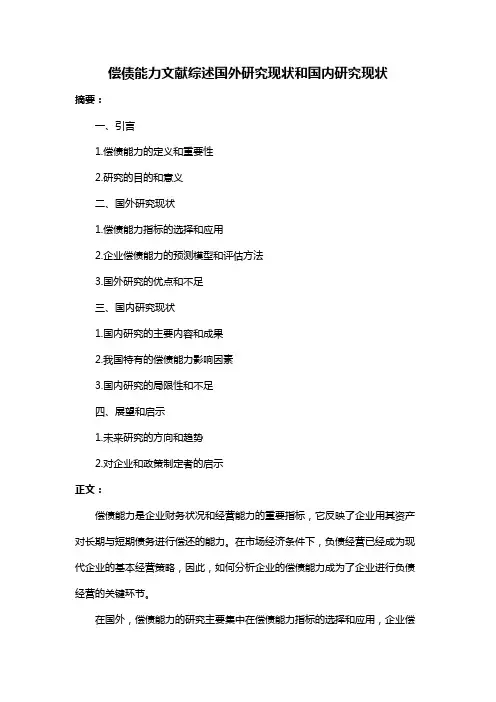
偿债能力文献综述国外研究现状和国内研究现状摘要:一、引言1.偿债能力的定义和重要性2.研究的目的和意义二、国外研究现状1.偿债能力指标的选择和应用2.企业偿债能力的预测模型和评估方法3.国外研究的优点和不足三、国内研究现状1.国内研究的主要内容和成果2.我国特有的偿债能力影响因素3.国内研究的局限性和不足四、展望和启示1.未来研究的方向和趋势2.对企业和政策制定者的启示正文:偿债能力是企业财务状况和经营能力的重要指标,它反映了企业用其资产对长期与短期债务进行偿还的能力。
在市场经济条件下,负债经营已经成为现代企业的基本经营策略,因此,如何分析企业的偿债能力成为了企业进行负债经营的关键环节。
在国外,偿债能力的研究主要集中在偿债能力指标的选择和应用,企业偿债能力的预测模型和评估方法等方面。
研究者们普遍认为,偿债能力指标应该包括企业的负债水平、盈利能力、流动比率、速动比率等多个方面。
这些指标不仅可以全面反映企业的财务状况,而且可以帮助企业预测未来的偿债风险。
然而,国外研究也存在一些不足,比如对特定行业和企业的偿债能力分析不够深入,对我国企业的适用性有限。
在国内,偿债能力的研究也在不断深入。
研究者们不仅对偿债能力的定义和重要性进行了阐述,而且对我国特有的偿债能力影响因素进行了深入分析。
例如,我国的企业信用体系不完善,企业的债务违约风险较高,这就需要在偿债能力分析中考虑到这一因素。
同时,国内研究也对企业的偿债能力评估方法进行了探索,提出了一些适合我国企业的评估模型。
然而,国内研究也存在一些局限性和不足,比如研究方法过于理论化,对实际操作的指导作用有限。
展望未来,偿债能力的研究将更加注重实用性和可操作性。
未来的研究应该更加关注企业的实际情况,提出更加符合我国企业特点的偿债能力评估方法和模型。
同时,研究者们也需要关注我国的市场环境变化,及时调整和完善偿债能力的研究内容。
对企业来说,偿债能力的分析不仅可以帮助他们更好地掌握自己的财务状况,还可以为他们的负债经营提供决策依据。
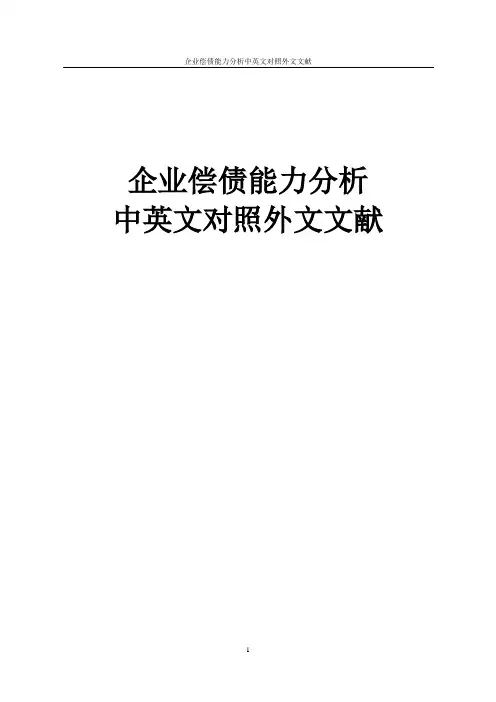
企业偿债能力分析中英文对照外文文献原稿IntroductionAlthough creditors can develop a variety of protective provisions to protect their own interests, but a number of complementary measures are critical to effectively safeguard their interests have to see the company's solvency. Therefore, to improve a company's solvency Liabilities are on the rise. On the other hand, the stronger a company's solvency the easier cash investments required for the project, whose total assets are often relatively low debt ratio, which is the point of the pecking order theory of phase agreement. Similarly, a company's short-term liquidity, the stronger the short-term debt ratio is also lower, long-term solvency, the stronger the long-term debt ratio is also lower .Harris et al. Well, Eriotis etc. as well as empirical research and Underperformance found that the solvency (in the quick ratio and interest coverage ratio, respectively, short-term solvency and long-term solvency) to total debt ratio has significant negative correlation. Taking into account the data collected convenience, this paper represents short-term solvency ratios and to study the long-term solvency by the quick ratio and cash flow impact on the real estate debt capital structure of listed companies.Listed Companies Solvency AnalysisWhen companies need money, the choice of financing preference order, namely in accordance with retained earnings, issuance of bonds, financing order issued shares. According to this theory, strong corporate profitability, retained earnings more For financing first will consider retained earnings. Therefore, the profitability of the total debt ratio should be negatively correlated debt avoidance theory based natural surface that under otherwise identical conditions, a highly profitable company should borrow more debt, because they use avoidance of the need for greater debt, and therefore higher debt ratio. rapid growth of the company's financial leverage without the support, based on this, to select 378 samples from the 500 largest US companies, the researchers found that regardless of whether there is an optimal capital structure, the company's liabilities are directly correlated with growth.Growth is the fundamental guarantee company solvency, so whether short-term loans or long-term loans and creditors, as the company's growth as a positive signal, so the listed companies in recent years of growth, the higher its rate and short-term assets The higher rate of long-term assets and liabilities, total assets and liabilities naturally higher, but the impact on growth of real estate companies listed on a smaller debt ratio (coefficient is small). The risk of firm size and capital structure affect the growth has a similar conclusion, it appears that creditors, especially banks that the company scale is a measure of credit risk is an important consideration index, the greater the company size, the more stable cash flow, bankruptcy it is smaller, the creditors are more willing to throw an olive branch large-scale enterprises. The actual controller of the listed companies category to total debt ratio of the impact factor of a 0.040017, indicating that non-state-controlled listed company's total assets and liabilities higher than the state-owned holding companies. The reason for this phenomenon may be non-state-controlled listed companies pay more attention to control benefits, do not want to dilute their control over equity financing, and therefore more inclined to debt financing, which may also explain the non-state-controlled listed companies better use of financial leverage enterprises bigger and stronger impulses. In addition, the actual control of listed companies category short-term impact on asset-liability ratio is a 2.3 times its impact on long-term debt ratio, which shows the non-state-controlled listed companies prefer to take advantage of short-term debt to expand its operations.Current research on factors affecting capital structure point of view there are many factors in various industries concerned is not the same, according to industry characteristics and particularity, we mainly focus on the following aspects to analyze the factors industry capital structure. The article explained variable - capital structure for the asset-liability ratio, generally refers to the total debt ratio, but for more in-depth study of capital structure of listed companies, the paper from the total debt ratio, short-term assets and liabilities and long-term debt ratio of three angles of Capital structure explanatory.At present, domestic and foreign scholars analyzed factors on capital structure mostly used multiple linear regression, as usual statistical regression function in the form of their choice is often subjective factors, but ordinary regression methods to make function with average resistance, most such functions excellent and objectivity are often difficult toreflect. base stochastic frontier model (Stochastic Frontier) in data envelopment analysis (DEA) method, estimate the effective production frontier using mathematical programming method, namely the experience of frontier production function, overcome DEA method assumes that there is no random error term, the better to reflect the objectivity and optimality ¨J function, currently in the field of economic management, sociology and medicine, began to get more and more applications. Therefore, in this paper, stochastic frontier model data on the capital structure factors listed real estate companies conducted a comprehensive analysis, in order to provide a better scientific basis for the study of the optimal capital structure of real estate enterprises.Listed company's solvency and overall asset-liability ratio was significantly negatively correlated with short-term liquidity has a decisive influence on the short-term asset-liability ratio. Similarly, long-term solvency also has a decisive influence on long-term assets and liabilities. Industry higher total debt ratio particularly high proportion of short-term debt is one of the main business risks, thus increasing solvency of listed companies, especially short-term liquidity (that is, to obtain a stable short-term cash flow). reduce its asset liability ratio and effective risk management choice ROA of listed companies is much greater influence than ROE of asset-liability ratio, and affect the relationship is inconsistent, ROE is higher, the higher the total debt ratio, while the ROA high, the lower the rate of the total assets and liabilities, and short-term liabilities ROA more obvious, this difference is mainly due to the special structure of listed companies due to the nature of the capital, and therefore need to improve the capital structure of listed companies, namely to reduce the total assets and liabilities rate debt structure and the need to reduce the proportion of short-term debt in particular, in order to enhance the company's profitability ROA. growth and company size has a significant positive impact on the capital structure, which is mainly due to the growth of the company's solvency is fundamental, The size of the company is the main indicator to measure the bankruptcy creditor risk. Therefore, listed companies should be radically to grow through continuous growth and development of enterprises, so that the total debt ratio has a high margin of safety, through growth to continue to resolve the financial risk than non-state-owned holding companies controlling more use of financial leverage motivation and apparently relied on short-term liabilities, which may lead to moreserious financial risk especially short-term business risks, so that the non-state-owned holding listed companies should establish more strict risk prevention system.译文。
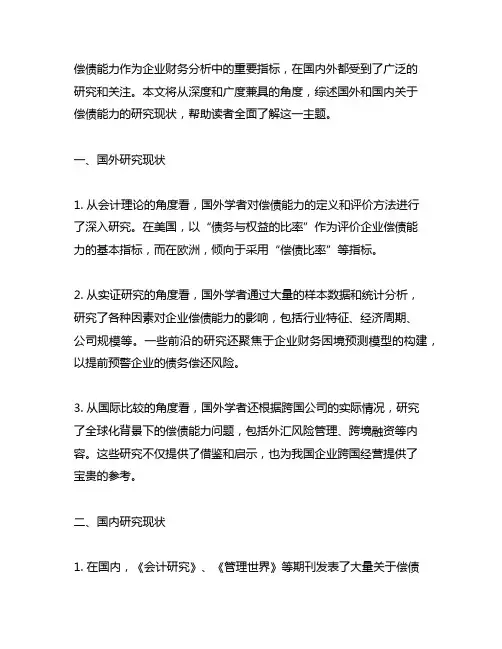
偿债能力作为企业财务分析中的重要指标,在国内外都受到了广泛的研究和关注。
本文将从深度和广度兼具的角度,综述国外和国内关于偿债能力的研究现状,帮助读者全面了解这一主题。
一、国外研究现状1. 从会计理论的角度看,国外学者对偿债能力的定义和评价方法进行了深入研究。
在美国,以“债务与权益的比率”作为评价企业偿债能力的基本指标,而在欧洲,倾向于采用“偿债比率”等指标。
2. 从实证研究的角度看,国外学者通过大量的样本数据和统计分析,研究了各种因素对企业偿债能力的影响,包括行业特征、经济周期、公司规模等。
一些前沿的研究还聚焦于企业财务困境预测模型的构建,以提前预警企业的债务偿还风险。
3. 从国际比较的角度看,国外学者还根据跨国公司的实际情况,研究了全球化背景下的偿债能力问题,包括外汇风险管理、跨境融资等内容。
这些研究不仅提供了借鉴和启示,也为我国企业跨国经营提供了宝贵的参考。
二、国内研究现状1. 在国内,《会计研究》、《管理世界》等期刊发表了大量关于偿债能力的研究论文。
其中,不乏一些针对我国市场和企业特点的理论探讨和实证研究,为国内企业财务管理提供了有益的启示。
2. 在监管政策的影响下,国内学者也研究了与企业偿债能力相关的会计准则和政策调整。
这些研究既有助于我国企业更好地理解和遵循相关法规,也有助于学术界对政策实施效果的评估。
3. 国内研究也逐渐关注与偿债能力相关的新兴话题,如企业绿色金融、社会责任等,试图探索企业可持续发展和偿债能力之间的关系。
这些研究丰富了我国学术界对偿债能力的认识,也为企业实践提供了新的思路。
三、个人观点和理解在国外研究现状方面,我认为国外学者在偿债能力的研究中,更注重理论与实证相结合,以及与国际接轨,这为我国企业提供了一个有益的参照标准。
而国内研究虽有所欠缺,但在特定市场和政策环境下的研究对我国企业具有直接的指导意义。
对于未来的研究方向,我期待国内学者能与国际接轨,更多地开展前沿研究,并结合我国特色,为企业提供更有针对性的理论指导和实践建议。
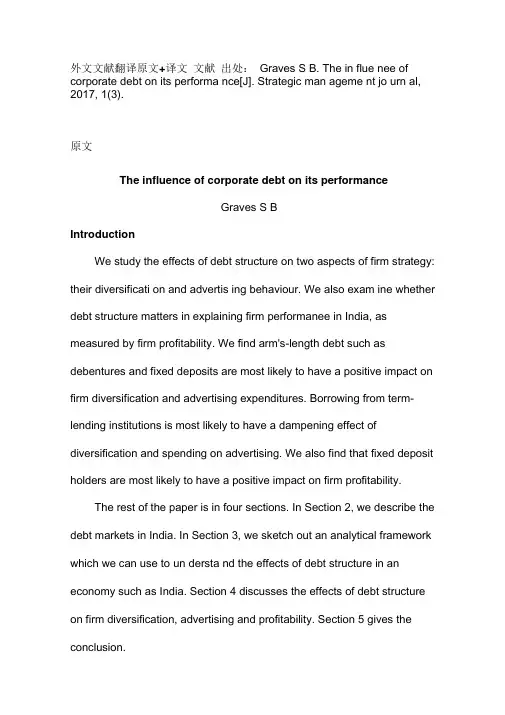

企业财务核心能力问题研究国内外文献综述(一)国外研究综述核心能力这一概念是Prahalad 和Hame 首次提出的,二十世纪九十年代,他们在《公司的核心能力》一文中提到企业核心能力是组织中的积累性学识,核心能力能够为企业提供营养、维持和稳定、取得竞争优势,主要体现在企业协调不同生产技术和整合出多种多样技术流的能力。
自此开始,越来越多的学者开始关注核心能力的战略地位。
国外研究中主要产生了资源基础观、知识基础观和动态研究观等主流观点。
Parthasarathy(2007)通过财务核心能力评估的相对重要性对每个指标进行加权,使用历史财务数据预测公司的未来自由现金流量、可持续发展性和持续经营性,发现财务核心能力不仅能够衡量企业短期的财务绩效,还能衡量企业长期财务健康状况。
Peri Ivana(2017)研究了中小企业财务能力与企业绩效之间的关系,在理论背景和以往相关研究的基础上发现,财务能力是导致企业整体成功的决定因素,尤其是缺乏资金、技能、技术和知识的中小企业。
资源基础观是较早的核心能力主流观点,认为企业内部对难以模仿的商业资源的创造、所有权、保护和使用是可持续竞争优势形成的基础。
资源基础观易使得企业依赖现有的资源从而产生惰性,造成既有优势转为劣势,较少关注外部环境。
Bowman 和Ambrosini(2003)结合Teece 的动态能力观,认为拥有并合理的调配资源能够创造价值,同时也指出企业中心可能拥有资源,但必须显示出动态调节能力,否则将破坏股东价值。
知识基础观认为,企业通过内部知识的创造、整合和对外部知识的利用,能够提升知识管理水平和竞争优势,推动实现价值目标。
Barton(1998)提出企业核心能力是指具有企业独特的、专有的企业知识和信息,企业通过对内部技能和知识整合能构建出“隐性知识能力”。
Teece(1997)提出动态能力框架,认为企业应关注外部环境变化,构建企业自身独特的协调和组合方式,提升应对复杂的外部环境的能力。
Solvency Analysis of Vanke GroupAbstractIn recent years, real estate companies have developed rapidly, and the real estate industry has become an important pillar to support the development of our national economy. If it is too hot in investing the real estate industry the continuous rise in housing prices will generate a lot of economic bubbles, and then trigger an economic crisis; if the investment is depressed, it will lead to an increase in the unemployment rate, which is not conducive to driving consumption and promoting economic development. Therefore, we must pay close attention to the development of the real estate industryAs we all know, the real estate industry has the characteristics of long investment cycles and large capital requirements. In order to maintain corporate development and exert financial leverage, real estate companies often have more debt, which has led to a high debt ratio in the real estate industry. Once the corporate capital chain Breakup, companies will fall into the crisis of mergers and acquisitions and bankruptcy. Coupled with the current unclear outlook of real estate, the analysis of the company's debt repayment ability by listed real estate companies is of vital importance to the companyThis article elaborates on the theory and basic concepts of solvency in theory, and then introduces in detail the specific indicators of enterprises in analyzing solvency. After giving a brief explanation of Vanke's enterprises, the author uses various debt repayment indicators to analyze Vanke's long-term and short-term solvency from 2010 to 2018, finds out the influencing factors that reduce Vanke's solvency, and then proposes solutions to improve Vanke’s solvency.Keywords: solvency,solvency indicators,ratio,Vanke万科集团偿债能力分析摘要近年来,房地产企业发展迅速,房地产行业已经成为支撑我国国民经济发展的重要支柱。
偿债能力英文参考文献Title: Literature Review on Debt Repayment AbilityIntroduction:Debt repayment ability is an essential aspect of financial management for individuals, businesses, and governments. It refers to the capacity to fulfill financial obligations by repaying debts promptly and in full. This article presents a literature review on debt repayment ability, examining various factors, indicators, and methodologies used to assess it. The review aims to provide a comprehensive understanding of the topic by exploring key studies and findings from academic journals, books, and research papers.Assessing Debt Repayment Ability:1. Financial Ratios:Financial ratios are commonly used to evaluate an entity's debt repayment ability. The most widely employed ratios include debt ratio, debt-to-equity ratio, interest coverage ratio, and the current ratio. These ratios provide insights into the proportion of debt to assets or equity, the ability to cover interest expenses, and current assets' sufficiency to meet short-term obligations.2. Cash Flow Analysis:Cash flow analysis helps determine the ability to generate adequate cash flows for debt repayment. The operating cash flow ratio, free cash flow, and cash flow coverage ratio are often examined to assess whether an entity can service its debt from its available cash flow.3. Credit Rating Agencies:Credit rating agencies play a crucial role in evaluating and assigning credit ratings to entities. These agencies assess an entity's debt repayment ability by considering variousfinancial indicators and factors such as profitability, liquidity, and leverage. The assigned credit ratings provide insights into an entity's reliability in repaying debts.Factors Affecting Debt Repayment Ability:1. Profitability:Entities with higher profitability are generally better positioned to service their debts promptly. Profit margin, return on assets, and return on equity are some indicators used to measure profitability and its impact on debt repayment ability.2. Liquidity:Liquidity measures an entity's ability to convert assets into cash quickly. Current assets such as cash, marketable securities, and accounts receivable are examined to assess whether an entity has sufficient liquid assets to meet its debt obligations.3. Leverage:Leverage refers to the extent of debt financing used by an entity. High levels of leverage may indicate increased financial risk and potential difficulties in repaying debt. Factors such as debt-to-equity ratio, interest coverage ratio, and debt-service coverage ratio are analyzed to evaluate the leverage's impact on debt repayment ability.Methods for Improving Debt Repayment Ability:1. Debt Restructuring:Debt restructuring involves modifying the terms of existing debts to enhance debt repayment ability. Strategies such as extending the repayment period, renegotiating interest rates, or converting debt into equity can provide relief to borrowers, enabling them to meet their debt obligations more effectively.2. Cost Reduction Measures:Implementing cost reduction measures can enhance cash flow and strengthen debt repayment ability. By optimizing operational expenses, businesses and individuals canallocate more funds towards debt servicing, thereby improving their overall debt repayment capability.3. Increasing Revenue Streams:Expanding revenue streams can augment an entity's capacity to repay debt by generating additional funds. Businesses can explore opportunities for diversification, market expansion, or introducing new product lines to increase revenue and improve their debt repayment ability.Conclusion:Assessing and improving debt repayment ability is crucial for individuals, businesses, and governments alike. Financial ratios, cash flow analysis, and credit rating agencies play significant roles in evaluating debt repayment ability. Factors such as profitability, liquidity, and leverage influence an entity's capability to service its debts. Methods like debt restructuring, cost reduction measures, and increasing revenue streams can aid in improving debt repayment ability. By considering these factors and strategies, entities can enhance their financial stability and effectively manage their debt obligations.。
2017年偿债能力文献偿债能力(debt-paying ability)是指企业用其资产偿还长期债务与短期债务的能力。
企业有无支付现金的能力和偿还债务能力,是企业能否健康生存和发展的关键。
企业偿债能力是反映企业财务状况和经营能力的重要标志。
偿债能力是企业偿还到期债务的承受能力或保证程度,包括偿还短期债务和长期债务的能力。
企业偿债能力,静态的讲,就是用企业资产清偿企业债务的能力;动态的讲,就是用企业资产和经营过程创造的收益偿还债务的能力。
企业有无现金支付能力和偿债能力是企业能否健康发展的关键。
偿债能力分析反映上市公司偿债能力的指标,主要有流动比率、速动比率、现金比率、资本周转率、清算价值比率和利息支付倍数等。
下面是小编为大家整理的2017年偿债能力文献,希望对大家有帮助。
2017年偿债能力文献篇一[1]鲁笛.公司财务分析―短期偿债能力分析[J].山东纺织经济,2012,10:36-38+73.[2]陈晓红.企业偿债能力分析探讨[J].浙江金融,2012,11:47-48.[3]夏红雨.企业偿债能力分析的新视角[J].会计之友(下旬刊),2010,03:20-22.[4]啜华,王月.基于现金流量的企业偿债能力分析[J].财会通讯,2013,11:67-68.[5]王琳,刘华志.企业偿债能力分析存在的问题及对策[J].现代经济信息,2011,19:228.2017年偿债能力文献篇二[1]陆正飞.财务报告与分析[M].北京大学出版社,2009[2]张先冶.财务分析[M].东北财经大学出版社,2011[3]王淑萍.财务报告分析[M].清华大学出版社,20112017年偿债能力文献篇三[1]纪会兰企业偿债能力分析应注意的问题[期刊论文]-合作经济与科技 2007(12)[2]刘可谈对企业偿债能力的分析 2008(09)[3]简建辉;董艳议企业偿债能力分析中的几个问题[期刊论文]-会计之友2006(36)析―短期偿债能力分析[J].山东纺织经济,2012,10:36-38+73.[2]陈晓红.企业偿债能力分析探讨[J].浙江金融,2012,11:47-48.[3]夏红雨.企业偿债能力分析的新视角[J].会计之友(下旬刊),2010,03:20-22.[4]啜华,王月.基于现金流量的企业偿债能力分析[J].财会通讯,2013,11:67-68.[5]王琳,刘华志.企业偿债能力分析存在的问题及对策[J].现代经济信息,2011,19:228.2017年偿债能力文献偿债能力(debt-paying ability)是指企业用其资产偿还长期债务与短期债务的能力。
北京化工大学北方学院毕业设计(论文)——外文文献原稿和译文外文文献原稿和译文原稿IntroductionAlthough creditors can develop a variety of protective provisions to protect their own interests, but a number of complementary measures are critical to effectively safeguard their interests have to see the company's solvency. Therefore, to improve a company's solvency Liabilities are on the rise. On the other hand, the stronger a company's solvency the easier cash investments required for the project, whose total assets are often relatively low debt ratio, which is the point of the pecking order theory of phase agreement. Similarly, a company's short-term liquidity, the stronger the short-term debt ratio is also lower, long-term solvency, the stronger the long-term debt ratio is also lower .Harris et al. Well, Eriotis etc. as well as empirical research and Underperformance found that the solvency (in the quick ratio and interest coverage ratio, respectively, short-term solvency and long-term solvency) to total debt ratio has significant negative correlation. Taking into account the data collected convenience, this paper represents short-term solvency ratios and to study the long-term solvency by the quick ratio and cash flow impact on the real estate debt capital structure of listed companies.Listed Companies Solvency AnalysisWhen companies need money, the choice of financing preference order, namely in accordance with retained earnings, issuance of bonds, financing order issued shares. According to this theory, strong corporate profitability, retained earnings more For financing first will consider retained earnings. Therefore, the profitability of the total debt ratio should be negatively correlated debt avoidance theory based natural surface that under otherwise identical conditions, a highly profitable company should borrow more debt, because they use avoidance of the need for greater debt, and therefore higher debt ratio.北京化工大学北方学院毕业设计(论文)——外文文献原稿和译文rapid growth of the company's financial leverage without the support, based on this, to select 378 samples from the 500 largest US companies, the researchers found that regardless of whether there is an optimal capital structure, the company's liabilities are directly correlated with growth.Growth is the fundamental guarantee company solvency, so whether short-term loans or long-term loans and creditors, as the company's growth as a positive signal, so the listed companies in recent years of growth, the higher its rate and short-term assets The higher rate of long-term assets and liabilities, total assets and liabilities naturally higher, but the impact on growth of real estate companies listed on a smaller debt ratio (coefficient is small). The risk of firm size and capital structure affect the growth has a similar conclusion, it appears that creditors, especially banks that the company scale is a measure of credit risk is an important consideration index, the greater the company size, the more stable cash flow, bankruptcy it is smaller, the creditors are more willing to throw an olive branch large-scale enterprises. The actual controller of the listed companies category to total debt ratio of the impact factor of a 0.040017, indicating that non-state-controlled listed company's total assets and liabilities higher than the state-owned holding companies. The reason for this phenomenon may be non-state-controlled listed companies pay more attention to control benefits, do not want to dilute their control over equity financing, and therefore more inclined to debt financing, which may also explain the non-state-controlled listed companies better use of financial leverage enterprises bigger and stronger impulses. In addition, the actual control of listed companies category short-term impact on asset-liability ratio is a 2.3 times its impact on long-term debt ratio, which shows the non-state-controlled listed companies prefer to take advantage of short-term debt to expand its operations.Current research on factors affecting capital structure point of view there are many factors in various industries concerned is not the same, according to industry characteristics and particularity, we mainly focus on the following aspects to analyze the factors industry capital structure. The article explained variable - capital structure for the asset-liability ratio, generally refers to the total debt ratio, but for more in-depth study of capital structure of listed companies, the paper from the total debt ratio, short-term assets and liabilities and北京化工大学北方学院毕业设计(论文)——外文文献原稿和译文long-term debt ratio of three angles of Capital structure explanatory.At present, domestic and foreign scholars analyzed factors on capital structure mostly used multiple linear regression, as usual statistical regression function in the form of their choice is often subjective factors, but ordinary regression methods to make function with average resistance, most such functions excellent and objectivity are often difficult to reflect. base stochastic frontier model (Stochastic Frontier) in data envelopment analysis (DEA) method, estimate the effective production frontier using mathematical programming method, namely the experience of frontier production function, overcome DEA method assumes that there is no random error term, the better to reflect the objectivity and optimality ¨J function, currently in the field of economic management, sociology and medicine, began to get more and more applications. Therefore, in this paper, stochastic frontier model data on the capital structure factors listed real estate companies conducted a comprehensive analysis, in order to provide a better scientific basis for the study of the optimal capital structure of real estate enterprises.Listed company's solvency and overall asset-liability ratio was significantly negatively correlated with short-term liquidity has a decisive influence on the short-term asset-liability ratio. Similarly, long-term solvency also has a decisive influence on long-term assets and liabilities. Industry higher total debt ratio particularly high proportion of short-term debt is one of the main business risks, thus increasing solvency of listed companies, especially short-term liquidity (that is, to obtain a stable short-term cash flow). reduce its asset liability ratio and effective risk management choice ROA of listed companies is much greater influence than ROE of asset-liability ratio, and affect the relationship is inconsistent, ROE is higher, the higher the total debt ratio, while the ROA high, the lower the rate of the total assets and liabilities, and short-term liabilities ROA more obvious, this difference is mainly due to the special structure of listed companies due to the nature of the capital, and therefore need to improve the capital structure of listed companies, namely to reduce the total assets and liabilities rate debt structure and the need to reduce the proportion of short-term debt in particular, in order to enhance the company's profitability ROA. growth and company size has a significant positive impact on the capital structure, which is mainly北京化工大学北方学院毕业设计(论文)——外文文献原稿和译文due to the growth of the company's solvency is fundamental, The size of the company is the main indicator to measure the bankruptcy creditor risk. Therefore, listed companies should be radically to grow through continuous growth and development of enterprises, so that the total debt ratio has a high margin of safety, through growth to continue to resolve the financial risk than non-state-owned holding companies controlling more use of financial leverage motivation and apparently relied on short-term liabilities, which may lead to more serious financial risk especially short-term business risks, so that the non-state-owned holding listed companies should establish more strict risk prevention system.北京化工大学北方学院毕业设计(论文)——外文文献原稿和译文译文介绍虽然债权人可以通过制定各种保护性条款来保障自己的利益,但都是一些辅助性的措施,能够有效保障他们利益的关键还得看公司的偿债能力。